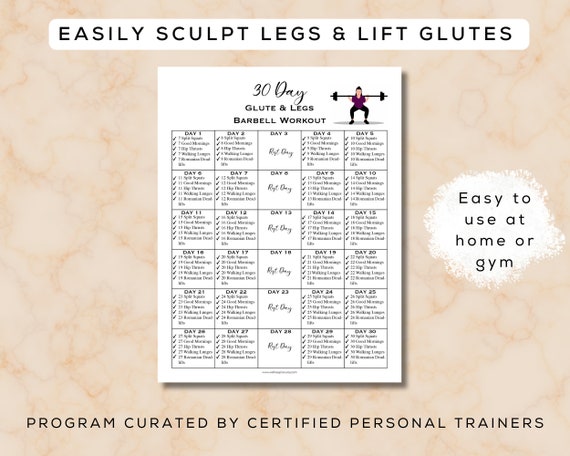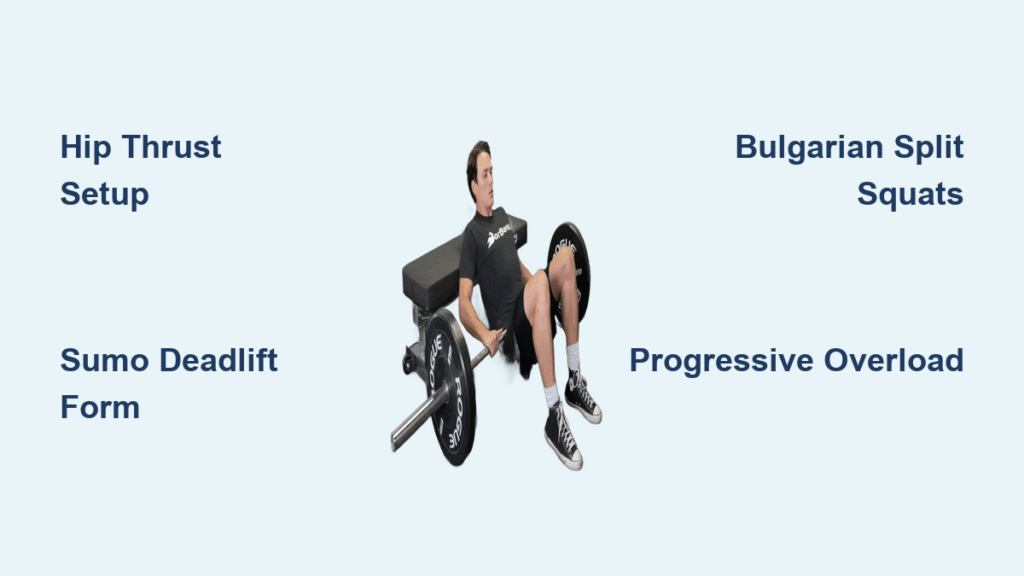Your glutes aren’t just for show—they’re the engine behind explosive jumps, heavy lifts, and injury-proof movement. When your barbell glute workout fails to deliver noticeable strength or shape improvements, it’s usually because you’re missing the precise exercises and loading strategies that trigger real growth. Barbell training dominates other methods by allowing 10-20% heavier loads than dumbbells while reducing stabilization demands, directly targeting your gluteal complex for maximum development.
This guide cuts through fitness misinformation with science-backed protocols used by elite strength coaches. You’ll discover exactly which barbell movements create the deepest glute activation, how to progressively overload without injury, and why most people sabotage their results with subtle form errors. Whether you’re a beginner or experienced lifter, these actionable techniques will transform your posterior chain within 8 weeks—no more spinning your wheels with ineffective routines.
Master These 3 Foundational Barbell Glute Exercises

Barbell Hip Thrust Setup for Maximum Activation
Position yourself seated on the floor with your upper back against a 12-14 inch bench, legs extended straight ahead. Roll the loaded barbell over your thighs until it rests comfortably across your hip bones—always use a padded barbell sleeve to prevent bruising. Secure the bench against a wall, then place your feet hip-width apart with heels drawn close enough that your shins turn vertical at the top position.
Drive powerfully through your heels while extending hips straight up until your body forms a straight line from knees to shoulders. Squeeze your glutes intensely at the peak, creating a posterior pelvic tilt (imagine tucking your tailbone under). Control the descent for 3-4 seconds without letting the bar touch the floor between reps—this constant tension doubles muscle damage for growth. Critical adjustment: Lifters under 5’2″ or with long legs need a 12-inch bench or 5-10lb plates under their feet to achieve full hip extension.
Glute Bridge Progression Pathway
Lie flat on your back with knees bent at 90 degrees and feet flat on the floor. Roll the barbell to your hip crease, gripping it wider than shoulder-width for stability. Drive through your heels to lift your hips until your body forms a straight line from knees to shoulders, focusing on maximal glute squeeze at the top while avoiding lower back arching.
Start with 3 sets of 12 controlled reps, emphasizing a 3-4 second lowering phase. Once you master this, progress to 4 sets of 6 heavy reps for strength development. Avoid this mistake: Letting your hips drop too fast between reps. Instead, maintain barbell pressure on your hips throughout—this continuous tension builds glute endurance before advancing to single-leg variations or elevated foot positions.
Kneeling Squat Technique for Targeted Growth
Set up in a squat rack with the barbell positioned at shoulder height while kneeling on a padded mat. Unrack the bar across your rear shoulders as in a back squat. Maintain a perfectly straight spine with a posterior pelvic tilt (ribs down, belt buckle up) and brace your core throughout.
Hinge your hips straight backward while keeping your torso upright—this vertical hip extension uniquely isolates glutes while minimizing knee stress. Feel the deep stretch in your glutes at the bottom, then drive upward through conscious glute activation. Key visual cue: Your knees should track over your second toes without caving inward. Perform 8-10 reps per set, emphasizing a 1-second peak contraction with posterior pelvic tilt on every rep.
Compound Lifts That Supercharge Glute Development
Back Squat Modifications for Glute Emphasis
Adopt a sumo stance (30-50% wider than shoulder-width) with toes slightly turned out. Place a resistance band around your knees and push outward against it throughout the movement to activate glute medius. Descend until your hip crease drops below your knee level—this deep position maximizes glute stretch.
Control the lowering phase for 3-4 seconds while keeping your chest up and core braced. Explode upward through your heels, driving your hips forward at the top for full glute contraction. Stance cheat sheet: Sumo stance increases glute activation by 40% versus standard stance. Box squats (pausing 1-2 seconds on a box) further shift emphasis to hip extensors.
Sumo Deadlift Form for Explosive Power
Position your feet in a wide stance with toes pointing 30-45 degrees outward. Grip the bar inside your knees with a mixed or overhand grip, retracting your shoulder blades. External rotate your femurs to align knees with foot direction—this prevents valgus collapse.
Drive through your heels while maintaining a straight back, keeping the bar path vertical against your legs. Complete each rep with a powerful hip thrust and glute squeeze at lockout. Critical fix: If your lower back rounds, reduce weight and practice hip hinging with bodyweight squats first. Sumo deadlifts increase glute activation by 25% compared to conventional versions while reducing spinal loading.
Unilateral Training for Balanced Glute Growth
Bulgarian Split Squats for Strength Imbalances

Place your rear foot on a bench behind you while holding a barbell across your shoulders. Lean your torso forward 20-30 degrees to shift emphasis from quads to glutes. Lower until your rear knee nearly touches the floor, keeping your front knee tracking over toes.
Drive upward through your front heel, avoiding assistance from your rear leg. Pro tip: Place a 5lb plate under your front heel if ankle mobility restricts depth—this allows deeper hip flexion for greater glute stretch. Perform 10-15 reps per leg, focusing on the eccentric phase to maximize time under tension.
Advanced Programming That Delivers Results
Power Development Protocol (206-Rep System)

Execute 4 rounds of this sequence twice weekly with 48 hours recovery between sessions:
– Barbell Hip Thrusts: 8-10 reps × 4 sets (maximal peak contraction)
– Box Back Squats: 5-7 reps × 4 sets (hip-dominant sumo stance)
– Stiff-Legged Deadlifts: 10-12 reps × 4 sets (high hip position)
– Deep Reverse Lunges: 12-15 reps × 3 sets (full hip flexion)
This protocol builds explosive power by alternating strength and hypertrophy stimuli. Rest 2-3 minutes between heavy sets, 60 seconds for lunge finishers. Track progress: When you hit the top of each rep range with RPE 7-8, increase weight by 2.5-5 pounds.
Progressive Overload Systems
Add 2.5-5 pounds immediately after completing all target reps with perfect form—don’t wait for multiple successful sessions. If progress stalls for two consecutive weeks, increase sets from 3 to 4 before adding weight. Range enhancement trick: Stand on 5-10lb plates during deficit deadlifts or elevate your shoulders 2 inches during hip thrusts to increase stretch under load by 15-20%.
Safety Protocols That Prevent Setbacks
Movement Quality Checklist (REP Model)
Assess every exercise using this simple framework:
– Repeatable: Can you maintain identical joint angles across all reps?
– Efficient: Is force transferring directly to the bar without energy leaks?
– Performance: Are you hitting required range, tempo, and activation targets?
Critical fix for lumbar hyperextension: During hip thrusts and squats, consciously perform a posterior pelvic tilt at the top—imagine zipping up a tight pair of jeans to engage glutes without arching your back.
Weekly Training Structure for Consistent Gains
Upper/Lower Split (4-Day Weekly Template)
Lower Day 1:
– Barbell Hip Thrusts: 4×8-10 (focus on peak squeeze)
– Bulgarian Split Squats: 3×12-15 per leg
– Glute Bridges: 3×15 with 3-second eccentric
Lower Day 2:
– Sumo Deadlifts: 4×4-6 (heavy)
– Romanian Deadlifts: 4×6-8 (controlled 3-second descent)
– Step-Ups: 3×10 per leg
Recovery rule: Never train glutes two days consecutively. Sleep 7-9 hours nightly—poor sleep reduces glute growth by 30% regardless of training intensity. Hit 1.6-2.2g protein per kg bodyweight daily, spread across 4-5 meals.
Final Note: Your barbell glute workout succeeds only when exercise selection, precise form, and progressive overload align. Start with two weekly sessions focusing on mastering hip thrusts and sumo deadlifts before adding complexity. Track every rep in a training log—when you consistently hit target weights with RPE 7-8, increase load. Strong glutes aren’t built through random effort but through intelligent, consistent application of these science-backed protocols. In 8 weeks, you’ll move with more power, lift with greater confidence, and finally see the results your hard work deserves.




